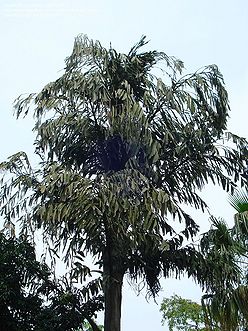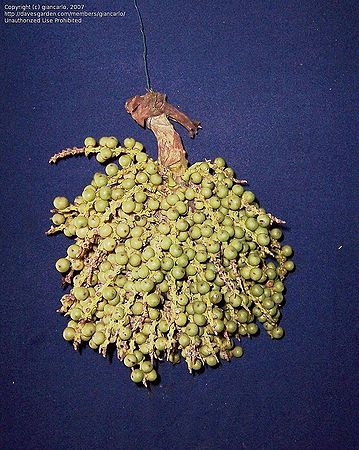Caryota mitis
| Caryota (kahr-ee-OH-tah) mitis (MEET-iss) | ||||||||
|---|---|---|---|---|---|---|---|---|
 | ||||||||
| Scientific Classification | ||||||||
| ||||||||
| Synonyms | ||||||||
|
| ||||||||
| Native Continent | ||||||||
|
| ||||||||
| Morphology | ||||||||
| ||||||||
| Culture | ||||||||
| ||||||||
| Survivability index | ||||||||
|
| ||||||||
| Common names | ||||||||
|
| ||||||||
Contents
Habitat and Distribution
Caryota mitis is native to southeast Asia where it grows as an emergent palm in tropical rain forests.Description
This is a clustering species, with many trunks to about 6 m (18 FEET) tall, with bipinnate leaves. Fishtail palms typically form multi-stemmed clusters, up to 25 ft (8 m) high and 12 ft (4 m) wide. Each slender stem is topped with several bipinnate leaves that can reach 9 ft (3 m) in length. The light green leaflets are shaped like a fish's tail fin, hence its common name (see photo below). Like other species in the genus (see C. urens), as well as the related genera Arenga (see A. engleri) and Wallichia, mature plants first begin flowering at the top of the stem. Subsequent flowering proceeds lower and lower down the stem. After the last flowering, the stem dies and should be removed. The clump will survive, however, and continue to produce more stems. Editing by edric.
Culture

Light: Fishtail palm thrives, full sun to part shade, will even tolerate full, but bright shade.
Moisture: This palm needs adequate moisture, but with good drainage.
Hardiness: USDA Zone 9b-10. This palm does well only in the warmest parts of Zone 9. It will tolerate light frosts, but is not hardy.
Propagation: Seeds take 4-6 months to germinate. Fishtail palm can also be propagated by division of clumps and separation of suckers from the parent cluster. The fishtail palm can be used in shrub borders and outdoor container plantings. It tolerates heavy shade and is often used in interior plantings in commercial buildings. It does well in indoor containers. Because it is shallow rooted, it should be planted in an area protected from wind. This palm is perfect for understory planting in woodland areas. The fishtail palm is a tough, easy to grow palm that makes a great houseplant, and is sometimes available from discount store garden centers at a reasonable price.
Comments and Curiosities
This is a monocarpic species.
Avoid contact with the red fruit produced by this palm. It contains oxalic acid which is toxic when ingested, and contact with skin may result in severe chemical burns. In India, an edible starch is extracted from the stem, and the palm heart eaten. Like other palms, it is also tapped for sap which is made into palm sugar or fermented to make toddy. The fuzz from the young leaves are used as tinder to start a fire. The palm is also used in construction. In India, the leaves are used for thatching or woven into household items, the fibres from the leaf sheath are made into rope, and seeds made into beads. However, the fruit and the whole plant can cause severe itching because they contain minute needle-like crystals.
| read more |
|---|
|
"This is a relatively commonly sold palm in the southern US, but it is not really one of the more ornamental of the Caryotas. It is one of the few suckering species, which helps to prolong its life- being monocarpic most Caryotas only live 10-30 years, but this one will keep suckering as other stems flower and die. This species is one of the less hardy ones, and doesn't look good in marginal climates. South Florida and Hawaii are about the only climates in the US this palm looks good in... though it does passably indoors. Not too many growers of this species in California would describe it as a nice looking tree. Note that the majority of clustering Caryotas sold in nurseries (usually as indoor plants) in the US are NOT this species, but are clumps of a solitary species (most likely C. urens or C. maxima)..." (Geoff Stein) "These palm are usualy devoid of nitrogen manganese and potassium in Southern CAlifornia. So if oyu want a green one fertilize it a lot more than you would with other palms." (Kyle Wicomb) The Clustered Fishtail Palm is probably the most widely grown of its kind, and for good reason. This foliage plant germinates and develops quickly, becoming an attractive, bushy, medium-sized palm, sporting many dark green, bipinnate leaves with fishtail-shaped leaflets that are unique to Caryota. C. mitis is native to Southeast Asia. It is a well-tested, easy-to-grow, and really reliable palm, and will grow in nearly any frost-free climate from warm temperate to tropical. (RPS.com) The Fishtail Palm has a unique flowering habit whereby the inflorescence develops from the top of the trunk first, followed by subsequent bunches moving downwards. The palm will die once it reaches is final seeding. The flowers are a pale cream colour, while the small 1 to 2 cm fruits are reddish-orange in colour. The fruit contains crystal oxalate which will irritate the eyes and skin. |
- IMAGE GALLERY
External Links
- Glossary of Palm Terms
- MODERN BOTANICAL LATIN
- "Just To Be Clear"
- http://itp.lucidcentral.org/id/palms/palm-id/Caryota_mitis.htm
References
Phonetic spelling of Latin names by edric.
Special thanks to Geoff Stein, (Palmbob) for his hundreds of photos.
Special thanks to Palmweb.org, Dr. John Dransfield, Dr. Bill Baker & team, for their volumes of information and photos.
Glossary of Palm Terms; Based on the glossary in Dransfield, J., N.W. Uhl, C.B. Asmussen-Lange, W.J. Baker, M.M. Harley & C.E. Lewis. 2008. Genera Palmarum - Evolution and Classification of the Palms. Royal Botanic Gardens, Kew. All images copyright of the artists and photographers (see images for credits).
Many Special Thanks to Ed Vaile for his long hours of tireless editing and numerous contributions.




































































